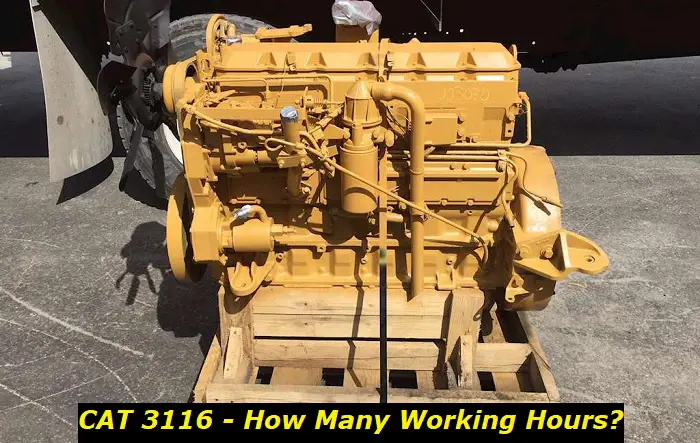3116 Cat Engine Life Expectancy: Prolonging Through Maintenance
The 3116 Cat Engine is a high-performing, reliable engine that powers a range of heavy machinery in various industries. Renowned both for its strength and durability, this engine, designed by Caterpillar, boasts specifications that meet the demanding needs of work environments such as construction sites or long-haul trucking industries. It is built with impressive power capacity and a fuel-efficient design, making it a preferred engine for many heavy-duty applications.
The life expectancy of the 3116 Cat Engine can vary depending on several factors, and understanding these will equip you to maximize the lifespan of your engine. These factors range from the engine's use environment to the frequency of maintenance. In-depth knowledge about these influencers can help operators and mechanics alike ensure that the engine performs optimally for a longer period. Our upcoming discussion will provide a detailed analysis of the typical life expectancy of the 3116 Cat Engine and outline ways to improve its longevity.

Understanding the Factors That Influence Engine Life Expectancy
Just like living beings, engines have life expectancies, too, and these are determined by a myriad of factors. As an experienced hand in heavy machinery, you're likely well aware that not all engines are created equal. Some are designed for extreme conditions, some for lightweight tasks, and some are robust and versatile enough to tackle varied applications. The 3116 Cat Engine belongs in this latter category, but even for this robust workhorse, certain factors can significantly influence its life expectancy.
One key factor that cannot be overlooked is the workload. The amount of strain we put on an engine directly impacts its longevity. If an engine is consistently pushed to its design's upper limits, it will inevitably wear out more quickly than if it is used for lighter duties. Furthermore, the operating environment equally plays a part. Engines exposed to extreme temperatures, dust, or corrosive substances will likely have a shortened lifespan.
Maintenance routines are another crucial factor. Regular oil changes, for example, help keep an engine's internal parts well-lubricated and free from damaging build-up. Timely replacements of filters, seals, and worn parts can also go a long way in keeping an engine healthy and extending its life.
Another important aspect to consider is the quality of fuel used. Inferior fuel may contain contaminations that accelerate engine wear and tear, while quality fuel can help maintain engine parts in ideal conditions. In terms of the 3116 Cat Engine, these elemental factors hold true. Prioritizing these considerations ensures that this engine, known for its durability and power, can reach or even surpass its expected lifespan.
Quality of installation can also determine engine life expectancy. Poor assembly can lead to unnecessary stresses put on engine components and consequently early failures. On this front, Caterpillar's meticulous assembly guidelines and procedures has been instrumental in assuring the longevity of the 3116 Cat Engine when installed correctly.
Typical Life Expectancy of the 3116 Cat Engine
Considered as one of the backbones in the heavy-duty machinery industry, the longevity of the 3116 Cat Engine is remarkable. As a seasoned mechanic, I bear testimony to the enduring performance of this model, and I can assure operators that, if well maintained, this powerhouse can deliver impeccable service for a fair number of years.
The 3116 Cat Engine is recognized for its momentum and, on average, can clock in several thousands of hours of operation before requiring significant overhauls. However, as with any machinery, the life expectancy isn't set in stone. It fluctuates considerably based on usage habits, operating conditions, adherence to maintenance schedules, and unforeseen mechanical mishaps. Still, under ideal conditions and with diligent upkeep, operators can expect longevity that outperforms many competing engine models in its class.
It's also commonplace, within the mechanic community, to compare the Cat 3116's life span with other engines. And time and again, the Cat 3116 has proven its resilience and endurance, achieving more operational hours on the whole compared to numerous other engines of the same class. This engine's reputation for durability and power output is widely recognized across the industry, making it a preferred choice for long-lasting, high-performance operations.
However, a friendly note of caution: always remember that engine life expectancy is a rough estimate and not a guarantee. Motor survival is subject to a myriad of factors, highlighted earlier. To truly grasp the exceptional life expectancy of your Cat 3116 engine, ensuring quality maintenance along with careful operational practices is a necessity, not an alternative.
Maintaining Your 3116 Cat Engine for Longevity
When it comes to improving the longevity of your 3116 Cat Engine, proper and frequent maintenance is the cornerstone. Like any other machinery, your engine thrives on a consistent maintenance schedule, a mechanism that keeps every part running optimally.
Commencing the maintenance routine, it's critically important to keep a vigilant check on your engine oil. Fresh, clean engine oil is the lifeblood of your 3116 Cat Engine. Frequent oil changes, in line with the manufacturer's guidelines, ensure smooth functioning by reducing friction between the moving parts and in turn preventing excessive heat generation. Remember, over time, oil becomes contaminated and loses its viscosity, so regular oil changes, typically after every 250-500 hours of operation (or as specified by the manufacturer), can keep the engine healthy.
Beyond oil checks, pay attention to the engine's cooling system. Overheating is a common cause for engine failure and can significantly decrease your engine's lifespan. Monitor the coolant regularly, keep it clean, and ensure the cooling system is functioning efficiently. Heat dissipation is as important as the engine's power generation.
The fuel system, another crucial area, demands your equal attention. Ensure regular checks and timely replacement of fuel filters. Coherent with this, keeping the injectors clean can help maintain the engine's performance and longevity. Dirty injectors can lead to fuel inefficiency, which puts unnecessary stress on the engine, reducing its lifespan.
Your maintenance routine should also encompass a comprehensive check of the engine's air filtration system. The air filter plays a pivotal role in keeping harmful debris and dust from entering the engine. A clean, functioning air filter will ensure the engine breathes freely, working towards its optimal performance and, ultimately, its longevity.
Last, but certainly not least, don't overlook the essence of visual inspections and preventative maintenance. Regular inspections can help you spot and rectify minor issues before they escalate into major engine problems. Implementing preventative measures like using genuine spare parts for replacements or repairs can greatly enhance your engine's life expectancy.
Keeping a keen eye on these areas can help secure your engine's robustness, ensuring it stands the test of time. As the maxim goes, "Prevention is better than cure", especially in the context of engine maintenance, where preventing potential issues is often less costly, both concerning time and money, than resolving serious engine malfunctions. Don't forget - a well-maintained 3116 Cat Engine is instrumental to its longevity.
A Close Look at the Common Problems and Solutions for the 3116 Cat Engine
Dealing with engine problems can be a challenge, but it becomes much less of a nightmare when you're equipped with know-how and practical solutions. Here's a close look at common issues you might run into with a 3116 Cat Engine, coupled with effective solutions.
Many operators have reported overheating issues with the 3116 Cat Engine. Overheating can be a symptom of a more significant problem, such as a clogged radiator or a faulty water pump. So how do you tackle this problem effectively? Start with a thorough inspection of the radiator, the coolant level, and the water pump. If the radiator is blocked, a detailed cleaning would be necessary, and a coolant refill might be needed if the levels are low. Damaged water pumps would need to be replaced promptly to prevent further complications.
The next common issue is excessive fuel consumption. While it's natural for heavy-duty engines like the 3116 to consume more fuel, the consumption could increase beyond the norm due to reasons like improper tuning or a dirty air filter. So, always ensure the engine is tuned correctly, and the air filter is cleaned or replaced when necessary.
Frequent starting problems are another issue reported by many operators. These can be caused by a weak battery, faulty starter motor, or even malfunctioning glow plugs. Thus, conducting regular checks on these components and replacing them when needed can help alleviate this problem and prevent unnecessary downtime.
The last of the common problems we'll touch on here is poor engine performance. Symptoms can range from loss of power to the engine running rough. It could be a signal that the fuel injectors are clogged, the fuel pump is malfunctioning, or the air intake is clogged. A comprehensive routine check-up of these components, followed by repair or replacement tasks, should bounce the engine back to its optimal performance.
While this is not an exhaustive list of all the issues that could arise with the 3116 Cat Engine, these are the ones most frequently encountered. Addressing these problems promptly and effectively will not only ensure the longevity of your engine but also its efficient performance.

Add comment